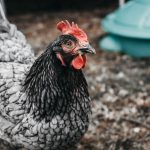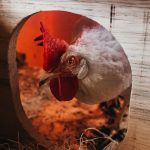Chickens exhibit natural behaviors that are important to consider when protecting them from predators. These birds are inherently inquisitive and social, with a strong drive to search for food. They are also easily frightened by abrupt movements or loud sounds.
Comprehending these behavioral traits is essential for effective predator protection. The daily routines of chickens are typically consistent. They follow a pattern of activities, including roosting at night and foraging during daylight hours.
This predictable behavior can help identify periods when chickens may be more susceptible to predator attacks, allowing for targeted protective measures. Within a flock, chickens establish a hierarchical social structure known as a pecking order. This social dynamic influences their interactions and behavior.
Understanding this aspect of chicken behavior can aid in managing their environment to reduce potential conflicts and stress, which in turn can contribute to better overall flock health and safety. By taking into account these natural behaviors and instincts, chicken keepers can develop more effective strategies for predator protection and overall flock management.
Table of Contents
- 1 Creating Physical Barriers
- 2 Implementing Visual Deterrents
- 3 Using Scents and Repellents
- 4 Training and Conditioning Techniques
- 5 Utilizing Natural Obstacles
- 6 Seeking Professional Assistance
- 7 FAQs
- 7.1 What are some natural ways to keep chickens out of certain areas without fencing?
- 7.2 How can physical barriers such as rocks or plants be used to keep chickens out of certain areas?
- 7.3 What are some examples of repellent plants or herbs that can be used to keep chickens out of certain areas?
- 7.4 How can distractions with alternative feeding areas help keep chickens out of certain areas?
Key Takeaways
- Chickens have natural behaviors such as scratching, pecking, and dust bathing that can be managed through understanding their behavior patterns.
- Physical barriers such as fences, netting, and hardware cloth can be effective in keeping chickens contained and predators out.
- Visual deterrents like scarecrows, reflective objects, and predator decoys can help deter predators from approaching chicken coops and runs.
- Scents and repellents such as predator urine, citrus peels, and garlic can be used to discourage predators from targeting chickens.
- Training and conditioning techniques, such as using positive reinforcement and creating a routine, can help chickens recognize and respond to potential threats.
- Natural obstacles like thorny bushes, dense vegetation, and natural topography can be utilized to create barriers and hiding spots for chickens.
- Seeking professional assistance from animal behaviorists, pest control experts, or experienced chicken keepers can provide valuable insights and solutions for predator management.
Creating Physical Barriers
Creating a Secure Perimeter
One of the most effective ways to protect your chickens from predators is by creating physical barriers around their coop and run. This can include installing a sturdy fence around the perimeter of the area, as well as adding a secure roof to prevent aerial attacks from birds of prey. Additionally, burying the fence underground can help deter digging predators such as foxes and raccoons.
Securing the Coop Itself
Another important aspect of creating physical barriers is ensuring that the coop itself is secure. This means using strong, predator-proof materials for the construction of the coop and run, as well as adding locks or latches to all doors and windows.
Maintenance and Inspection
It’s also important to regularly inspect the barriers for any signs of wear or damage, and make repairs as needed to maintain their effectiveness.
Implementing Visual Deterrents

Visual deterrents can be an effective way to keep predators away from your chickens. This can include using scarecrows, predator decoys, or reflective objects such as CDs or mirrors to create the illusion of a larger, more intimidating presence in the area. Additionally, motion-activated lights or sprinkler systems can startle predators and deter them from approaching the coop.
Another visual deterrent that can be effective is the use of predator eyes or faces on signs or flags. These can create the impression that a larger predator is present in the area, which can discourage smaller predators from approaching. It’s important to regularly move and change the placement of visual deterrents to prevent predators from becoming accustomed to them.
Using Scents and Repellents
Scents and repellents can be used to create a barrier around the chicken coop and run that deters predators from approaching. This can include using natural predator scents such as coyote or wolf urine, as well as commercial repellents that are designed to deter specific types of predators. Additionally, planting strong-smelling herbs or flowers around the perimeter of the coop can help mask the scent of the chickens and deter predators.
Another effective scent-based deterrent is the use of garlic or hot pepper spray around the coop and run. These scents are unpleasant to many predators and can help keep them at bay. It’s important to regularly reapply these scents and repellents, especially after heavy rain or wind that may wash or blow them away.
Training and Conditioning Techniques
Training and conditioning techniques can be used to teach chickens to recognize and respond to potential threats. This can include using a specific sound or signal to alert them to danger, such as clapping your hands or using a whistle. By consistently using this sound or signal in conjunction with a visual deterrent, you can condition the chickens to associate it with potential danger and take cover.
Another training technique is to use positive reinforcement to reward chickens for exhibiting safe behaviors, such as returning to the coop when called or staying close to the flock. This can be done by offering treats or praise when they respond appropriately to a signal or command. Consistent training and reinforcement can help chickens become more aware of potential threats and take proactive measures to protect themselves.
Utilizing Natural Obstacles

Using Natural Barriers to Deter Predators
Natural Obstacles as a Deterrent
Natural obstacles can be used to create a barrier around the chicken coop and run that deters predators from approaching. This can include using thorny bushes or dense vegetation to create a natural barrier, as well as incorporating natural features such as rocks or logs into the landscape to create hiding spots for the chickens.
Raised Beds and Elevated Platforms
Another natural obstacle that can be effective is the use of raised beds or elevated platforms within the run that provide the chickens with a safe place to retreat to if they feel threatened.
Creating a Complex Landscape
By incorporating natural obstacles into the environment, you can create a more complex and challenging landscape for predators to navigate, which can discourage them from approaching.
Seeking Professional Assistance
In some cases, it may be necessary to seek professional assistance in protecting your chickens from predators. This can include consulting with a wildlife expert or animal control officer to identify potential threats in your area and develop a comprehensive predator management plan. Additionally, hiring a professional contractor to install secure fencing or predator-proofing measures around the coop and run can ensure that your chickens are well-protected.
Another option for professional assistance is to work with a livestock guardian animal, such as a dog or llama, that is trained to protect chickens from predators. These animals can provide an added layer of security for your flock and help deter potential threats from approaching. It’s important to carefully research and select a guardian animal that is well-suited to your specific needs and environment.
In conclusion, protecting your chickens from predators requires a multi-faceted approach that incorporates an understanding of chicken behavior, physical barriers, visual deterrents, scents and repellents, training techniques, natural obstacles, and potentially seeking professional assistance. By implementing these strategies in combination with one another, you can create a safe and secure environment for your flock and minimize the risk of predation.
If you’re looking for ways to keep chickens out of certain areas without using fencing, you may also be interested in learning about the mating season for ducks. Check out this article to understand more about duck behavior and how it may impact your efforts to keep chickens away from specific areas.
FAQs
What are some natural ways to keep chickens out of certain areas without fencing?
Some natural ways to keep chickens out of certain areas without fencing include using physical barriers such as rocks or plants, using repellent plants or herbs, and creating distractions with alternative feeding areas.
How can physical barriers such as rocks or plants be used to keep chickens out of certain areas?
Physical barriers such as rocks or plants can be used to create obstacles that deter chickens from entering certain areas. Placing large rocks or dense plants along the perimeter of the area can make it difficult for chickens to access.
What are some examples of repellent plants or herbs that can be used to keep chickens out of certain areas?
Some examples of repellent plants or herbs that can be used to keep chickens out of certain areas include lavender, mint, marigolds, and rosemary. These plants have strong scents that chickens find unpleasant.
How can distractions with alternative feeding areas help keep chickens out of certain areas?
Creating alternative feeding areas with treats or scratch grains can distract chickens and draw them away from the areas you want to keep them out of. Placing these feeding areas in a different location can help redirect the chickens’ attention.

Meet Walter, the feathered-friend fanatic of Florida! Nestled in the sunshine state, Walter struts through life with his feathered companions, clucking his way to happiness. With a coop that’s fancier than a five-star hotel, he’s the Don Juan of the chicken world. When he’s not teaching his hens to do the cha-cha, you’ll find him in a heated debate with his prized rooster, Sir Clucks-a-Lot. Walter’s poultry passion is no yolk; he’s the sunny-side-up guy you never knew you needed in your flock of friends!
Meet Walter, the feathered-friend fanatic of Florida! Nestled in the sunshine state, Walter struts through life with his feathered companions, clucking his way to happiness. With a coop that’s fancier than a five-star hotel, he’s the Don Juan of the chicken world. When he’s not teaching his hens to do the cha-cha, you’ll find him in a heated debate with his prized rooster, Sir Clucks-a-Lot. Walter’s poultry passion is no yolk; he’s the sunny-side-up guy you never knew you needed in your flock of friends!








